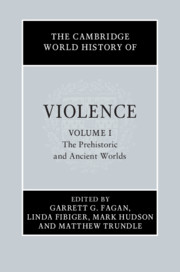Book contents
- The Cambridge World History of Violence
- The Cambridge History of Violence
- The Cambridge World History of Violence
- Copyright page
- Contents
- Figures
- Maps
- Contributors to Volume i
- General Introduction: Violence in World History
- Introduction to Volume I
- Part I The Origins of Conflict
- Part II Prehistoric and Ancient Warfare
- Part III Intimate and Collective Violence
- 14 Early Massacres: Mass Violence in Neolithic Europe
- 15 Gendered Violence in Iron Age and Roman Britain
- 16 Violence in Ancient Egyptian Society
- 17 Violence and the Mutilated Body in Achaemenid Iran
- 18 ‘Knocking Her Teeth out with a Stone’: Violence against Women in Ancient Greece
- 19 Gang Violence in the Late Roman Republic
- 20 Violence in Early Chinese History
- Part IV Religion, Ritual and Violence
- Part V Violence, Crime and the State
- Part VI Representations and Constructions of Violence
- Index
- References
14 - Early Massacres: Mass Violence in Neolithic Europe
from Part III - Intimate and Collective Violence
Published online by Cambridge University Press: 13 March 2020
- The Cambridge World History of Violence
- The Cambridge History of Violence
- The Cambridge World History of Violence
- Copyright page
- Contents
- Figures
- Maps
- Contributors to Volume i
- General Introduction: Violence in World History
- Introduction to Volume I
- Part I The Origins of Conflict
- Part II Prehistoric and Ancient Warfare
- Part III Intimate and Collective Violence
- 14 Early Massacres: Mass Violence in Neolithic Europe
- 15 Gendered Violence in Iron Age and Roman Britain
- 16 Violence in Ancient Egyptian Society
- 17 Violence and the Mutilated Body in Achaemenid Iran
- 18 ‘Knocking Her Teeth out with a Stone’: Violence against Women in Ancient Greece
- 19 Gang Violence in the Late Roman Republic
- 20 Violence in Early Chinese History
- Part IV Religion, Ritual and Violence
- Part V Violence, Crime and the State
- Part VI Representations and Constructions of Violence
- Index
- References
Summary
This chapter provides an overview of sites of mass violence from Early Neolithic central Europe. It focuses on the Linearbandkeramik (LBK), for which several such sites are now known, more than on other Neolithic cultures. It seems that the victims of mass violence were buried, if at all, by inclusion in disorganised mass graves without any sign of post-mortem care. This indicates intentional non-conformity to the usual burial practices of the LBK and thereby wilful neglect of the funerary expression of victims’ individual cultural identities. So far, every newly discovered mass-violence site has revealed new facets of violent behaviour, including likely evidence for massacres, selected capture, torture, mutilation and systematic execution. The bioarchaeological complexity of these mass-violence sites necessitates highly comparative approaches for their interpretation that incorporate all sites where human remains have been deposited as well as their periodic reappraisal. Currently, warfare seems to be the most plausible reason for most of the group violence encountered in the LBK, especially the drastic massacres of settled communities. LBK massacre victims are characterised by perimortem cranial injuries, careless deposition in settlement contexts, lack of post-mortem attention, and the suppression of their cultural identity.
- Type
- Chapter
- Information
- The Cambridge World History of Violence , pp. 299 - 319Publisher: Cambridge University PressPrint publication year: 2020
References
Bibliographic Essay
- 4
- Cited by

